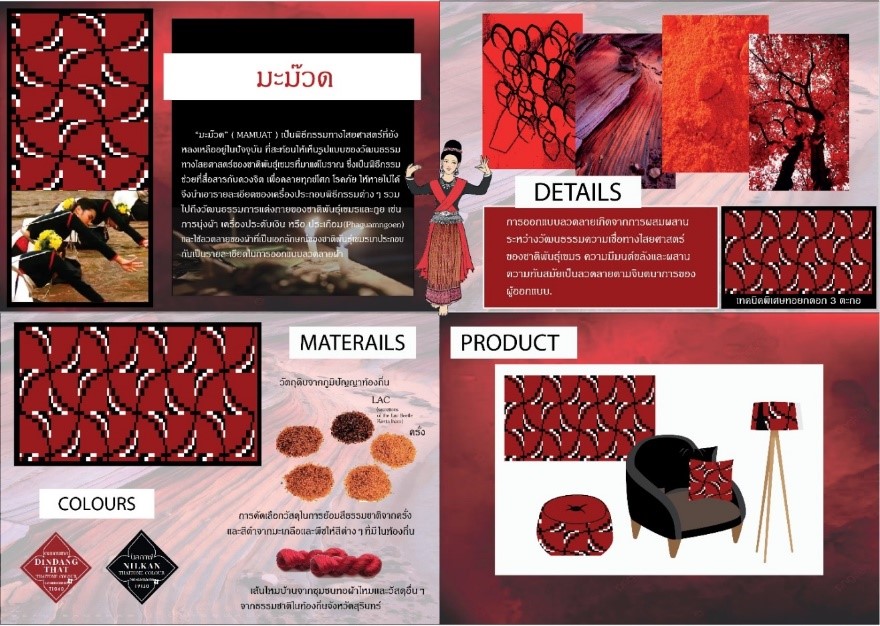Knowledge Management of Silk Manufacturing Processes Inspired By Folk Rituals, Surin Province
Main Article Content
Abstract
The objective of this research was to study the patterns and production processes inspired of silk inspired by local rituals in Surin province starting from the patterns designing, graph pattern counting, pattern tying, dyeing until the weaving into fabrics. The data collection was conducted by interviewing 5 ritual experts from Surin province and 10 silk weavers. The results found that there are many rituals in Surin Province. In this case, the researcher selected Mammut ritual which is a ritual that focuses on the relief of sorrows and disease, which is the Kui style consisting of silverware. As for the silk production process inspired by folk rituals, Surin province, here is the Ma Moat Ritual. The production of silk fabric inspired by local rituals in Surin Province. A case study of the Mammut ritual has 4 main steps: 1) designing fabric patterns inspired by local rituals, silk thread preparation using landing gear. The number of Lam Mee depends on the pattern of 28 Lam Mee or 58 Lam Mee, 3) dyeing with natural colors by tying the white pattern according to the graph to keep the white colors. Then, the red re-dying was performed before dying it in black with ebony and mud until it is completely black and 4) The process of weaving into a fabric, width 1 meter, length 2 meters, black warp dyed with chemical. The weft line are Mudmee and Mammut patterns, woven with 3 takors. From, the results of knowledge management after weaving into the finished fabric, it won the frist prize in the fabric design contest in the 10th World Silk Exposition was organized by the the Queen Sirikit Department of Sericulture, Ministry of Agriculture and Cooperatives. In addition, more than 40 pieces of Mammut pattern silk have been ordered, priced at 3,500 baht per piece, allowing the weavers to earn income as well as exchanging knowledge between members to create silk production to match. Inspiration.
Article Details
References
ฉวีวรรณ ปานชี จุฑามาส ศิริอังกูรวาณิช วราภรณ์ ภูริวรางกูร วิวัฒน์ จูวราหะวงศ์ อุไรวรรณ โชติวิท และอัญมณี ทองน้อย. (2548). รายงานการวิจัยและพัฒนาห้องสมุดมีชีวิตการจัดดการความรู้ภูมิปัญญาท้องถิ่นเพื่อพัฒนาอาชีพทำขนมโบราณชุมชนกุฎีจีน แขวงวัดกัลยาณ์ เขตธนบุรี กรุงเทพมหานคร. สำนักงานวิทยบริการและเทคโนโลยีสารสนเทศ มหาวิทยาลัยราชภัฎธนบุรี.
ชุติมา เมฆวรรณ. (2549). การจัดการความรู้ของกลุ่มธุรกิจชุมชนในจังหวัดร้อยเอ็ด[วิทยานิพนธ์ปริญญาโท] มหาวิทยาลัยขอนแก่น.
บุญดี บุญญากิจ นงลักษณ์ ประสบสุขโชคชัย ดิสพงศ์ พรชนกนาถ และปรียวรรณ กรรณล้วน(2547). การจัดการความรู้จากทฤษฎีสู่การปฏิบัติ. สถาบันเพิ่มผลผลิตแห่งชาติ.
ประภากร สุคนธมณี. (2551). เรื่องราวความนุกสนานของการทอผ้าไหมมัดหมี่. ภาควิชาประยุกต์ศิลปศึกษา คณะมัณฑนศิลป์ มหาวิทยาลัยศิลปากร.
ฐานิศวร์ ฐิติกุลภิรมย์. (2553). การสร้างสรรค์ลายมัดหมี่ด้วยเครื่องมือเชิงกราฟิก. [วิทยานิพนธ์ปริญญาโท] มหาวิทยาลัยศิลปากร.
วิทยา วิชาเรือง. (2543). ศักยภาพของสตรีในการดำเนินธุรกิจชุมชน กลุ่มสตรีทอผ้าไหมบ้านหนองแคน ตำบลหนองแคน อำเภอปทุมรัตน์ จังหวัดร้อยเอ็ด. [วิทยานิพนธ์ปริญญาโท] มหาวิทยาลัยมหาสารคาม.
สมชาย นำประเสริฐชัย. (2558). การจัดการความรู้. ซีเอ็ดยูเคชั่น.
วรรณดี สุทธินรากร. (2557). การวิจัยเชิงปฏิบัติการแบบมีส่วนร่วมและกระบวนการทางสำนึก. สยามปริทัศน์.
สุทธิพงศ์ จุลเจริญ. (2564, 25 มกราคม). ผ้ามัดหมี่ลายขอเจ้าฟ้าสิริวัณณวรีฯจุดประกายแห่งการพัฒนาภูมิปัญญาท้องถิ่น. สถาบันพัฒนาอุตสาหกรรมสิ่งทอ.https://www.thaitextile.org/th/insign/detail.2262.1.0.html
Phansuwan, W. (2010). A study of silk-cloth weaving development of the Mon-Khmer ethnic group in lower-Isan.Ph.D. in Cultural Science. Mahasarakham University.
Nonaka, I., & Takeuchi, H. (2011). The wise leader. Harvard business review, 89(5), 58-67.
Phansuwan, W. (2010). A study of silk-cloth weaving development of the Mon-Khmer ethnic group in lower-Isan.Ph.D. in Cultural Science. Mahasarakham University.
Wing, KM. (1999). The Inter Intelligent Enterprise and Knowledge Management. USA: Knowledge Research Institute, Inc.


